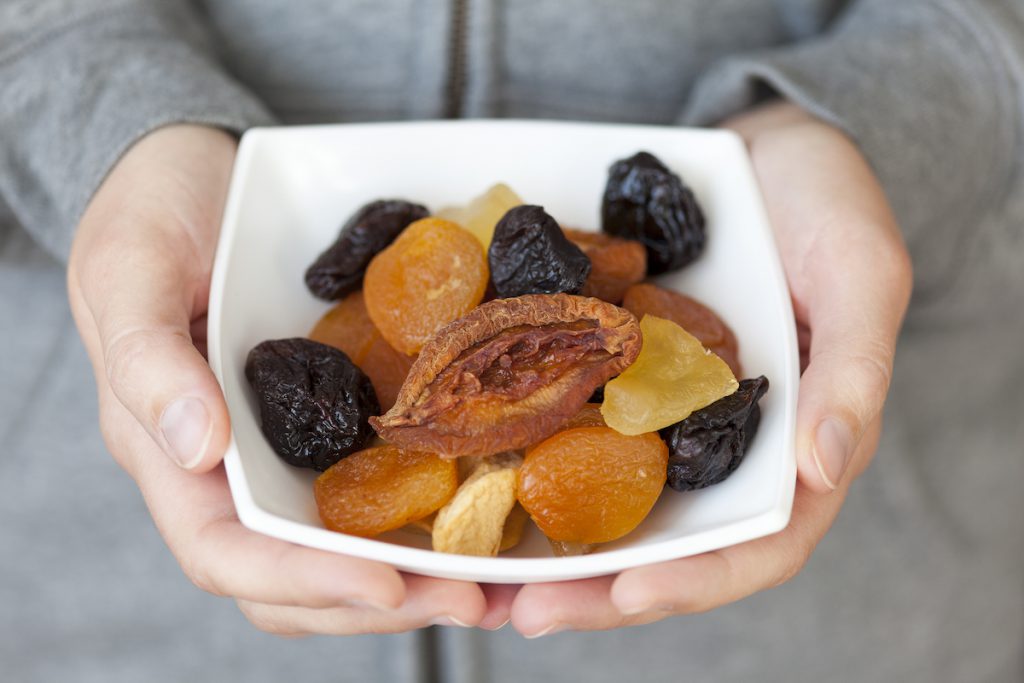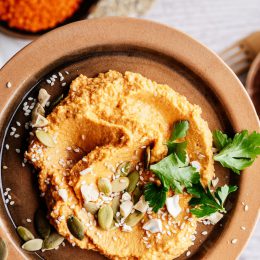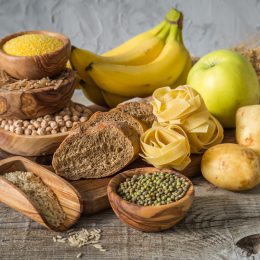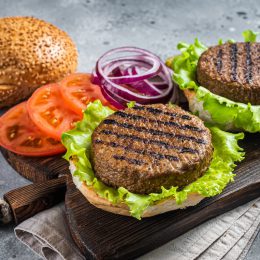Ask a Nutritionist: Is Dried Fruit as Healthy as Fresh?
When you aren’t eating enough fresh fruit, dried ones can help you get the nutrition you need. Here are the ones that are worth adding to your diet.

As you probably already know, fruit is an essential part of a healthy diet. It’s why nutrition experts recommend that people eat it every day. It provides you with ample fiber, vitamins, minerals, and antioxidants that support better health.
But despite all it has to offer, few older individuals eat the recommended amounts. Adults of all ages should eat 1.5 to 2 cups of fruit a day to reap their considerable health benefits. And dried fruit can definitely be a part of that.
Fruit consumption may matter a little more for the oldest among us. A study in the American Journal of Clinical Nutrition involving nearly 80,000 women over the age of 80 found that those who ate the most fruit were at a lower risk for physical weakness. Other research has discovered that older people who eat more fruit (and vegetables) are less likely to have cognitive decline.
But fruit is often sold in larger quantities, and it doesn’t stay fresh forever. One way to sidestep that problem? Dried fruit. It’s shelf-stable, convenient, and portable. But how does it stack up nutritionally?
Healthy eating and fitness are a perfect match! SilverSneakers classes and events are happening right now at participating gyms, online through SilverSneakers LIVE, and at community centers near you. Activate your free online account to get started.
Why Dried Fruit Is Healthy
Dried fruit is just regular fruit in dehydrated form. As a result of the drying process, most of the water of fresh fruit is taken out. This shrinks the fruit and gives it a shriveled and smaller appearance and a much longer shelf-life.
It also concentrates the nutrition of the fruit by weight. Per ounce, dried fruit like cranberries, cherries, apricots, and dates, has more gut-loving fiber, micronutrients, and antioxidants compared to fresh fruit. For example, one-quarter cup of raisins, which are dried grapes, contain about 6% of your daily value of potassium, roughly the same amount you’d get from one cup of fresh grapes.
Studies show that people who eat dried fruit are healthier than those who don’t. The Journal of the Academy of Nutrition and Dietetics reported that people who eat about a quarter cup of it daily have better overall diet quality and higher intakes of important nutrients like potassium and fiber than those who don’t consume any at all.
Plus, their body mass index, waist circumference, and systolic blood pressure were lower too. Dried fruit also has significant amounts of phytochemicals, which are plant compounds that help protect our cells.
The Drawbacks of Eating Dried Fruit
Despite the nutritional benefits, there are a couple of pitfalls too. Since the moisture has been removed, dried fruit is more concentrated in calories and sugar than fresh versions. Portion control is key. A cup of fresh apricots contains only 75 calories while the same amount of the dried version has about 313 calories.
Its size can be a little tricky too. When most of the water is removed, the fruit shrinks a lot, which can cause portion distortion. Would you eat 10 fresh plums? Probably not, but you could easily eat 10 dried plums without really thinking about it. A good rule of thumb is to limit portion sizes of dried fruit to about a quarter cup. But larger portions can be an excellent option for older people who have been instructed to gain weight.
Because of the high fiber and natural sugar content, eating too much dried fruit too quickly can cause some GI distress including bloating, gas, and diarrhea in some people. If you’re new to eating dried fruit, ease into it slowly.
The natural sugar in dried fruit isn’t a problem, but added sugars can be. Some contain juices, syrups, or even crystallized sugar. Be sure to read nutrition labels to look for options that just contain fruit. You should be wary of options labeled “crystallized” or “candied” — this is code for added sugar.
Overall, it’s a good idea have both fresh and dried fruit as part of your healthy diet. The fresh stuff adds to your daily hydration because of its natural water content, but dried fruit does not. Try to drink more water when you add dried fruit to your nutritional mix.
4 Top Dried Fruit Options for Seniors
Dried fruit is sweet and snackable, and there are so many different kinds to choose from.
I recommend these parched marvels to add a nutritious kick to your daily diet.
Dried plums. Also known as prunes, this fruit gained a reputation for more bowel activity. Research shows that the fiber in prunes can increase stool frequency and consistency. Since constipation is one of the leading gastrointestinal complaints among older Americans, this is a huge bonus.
Your bones may also benefit from dried plums. Nutrition scientists say that prunes can help slow bone loss in older adults, possibly by reducing chronic inflammation — a marker of many chronic diseases. Prunes add more potassium to your diet too, which helps keep blood pressure numbers in the safe zone.
Dried figs. These gems from the sunny Mediterranean are a surprising source of calcium — which is key to maintaining bone health if you don’t eat much dairy. A half-cup serving of dried figs also delivers an impressive 7 grams of fiber, which is among the highest levels of any dried fruit you can buy.
Why does fiber matter? Eating more fiber is associated with a lower risk of both cardiovascular disease and coronary heart disease, found a study in the journal BMJ. High-fiber foods like figs can also improve blood sugar and cholesterol numbers, which also boosts your heart health.
Dried apricots. Apricot season is but a blip on the calendar, however the dried version is available all year long. Among dried fruits, apricots lead the way in beta-carotene, an antioxidant linked to improved heart health and a lower risk of developing type 2 diabetes . Our bodies can convert beta-carotene into vitamin A, which helps strengthen bone and immune health.
Other tallies in the nutrient win column include fiber, potassium, vitamin E, and copper. If you’re sensitive to sulfites, sometimes the case for people who have asthma, look for organic versions that are not treated with that color-enhancing preservative. You can tell an apricot is sulfite-free when it’s brown and not bright orange.
Subscribe to our newsletter
It's quick and easy. You could be one of the 13 million people who are eligible.
Already a member? Click to discover our 15,000+ participating locations.
Follow Us
Currants. Despite their small size, they pack a powerful, sweet-tangy flavor that is stronger than raisins. Dried currants actually are tiny raisins, and they are made by drying a variety of seedless grape known as Black Corinth. They are not made with fresh currants, which are a type of berry.
Currants are fairly high in vitamin C, which supports healthy immune function. They’re also a good source of potassium, because that mineral that lessens the effects of sodium and helps lower blood pressure. The fiber in dried currants helps support a healthier digestive system, and their antioxidants may aid in improving brain functioning.
Recommended reading: 8 Delicious Ways to Eat Your Way to Better Brain Health
How to Eat Dried Fruit
Aside from snacking on them or tossing together a homemade trail mix, you can also add dried fruit to hot or cold cereals, a bowl of yogurt, baked goods, and even salads. They can also add a sweet element to stews, curries, beans, and roasted vegetables.
Dried fruit can also be used to make sauces and toppings. Poach dried fruit with some water and cinnamon to use on pancakes. Dried cherries, apricots, and figs are excellent ingredients in chutneys that can be paired with meat.
Dried fruit is also used as a sweetener in baking. Place a cup of dried fruit (dates, prunes, currants, and raisins work well for this) in a bowl, cover with water, and let it soak for a couple of hours. Drain and blend rehydrated fruit in a food processor into a smooth purée. You can replace half the sugar in baked good recipes like brownies and muffins with the fruit purée.
For people on the move, dried fruit can be a perfect pre-workout snack. Since they are mainly carbohydrates, just a handful will provide quick energy and will be easy to digest.
See our sources:
Fruit intake recommendations: Centers for Disease Control and Prevention
Fruit intake and frailty: The American Journal of Clinical Nutrition
Produce and cognitive decline: Frontiers in Nutrition
Dried fruit and nutrient consumption: Journal of the Academy of Nutrition and Dietetics
Prunes and bowel activity: Alimentary Pharmacology and Therapeutics
Fiber and heart disease risk: BMJ
Check Your SilverSneakers Eligibility Instantly
SilverSneakers members can go to thousands of nationwide gyms and fitness locations, plus take SilverSneakers LIVE online classes that are designed for all fitness levels and abilities. If you have a Medicare Advantage plan, it may include SilverSneakers — at no additional cost. Check your eligibility instantly here.
Already a member? Get your SilverSneakers member ID and exclusive fitness and wellness content by activating your online account here.
Not eligible for SilverSneakers? You can still get 200+ free SilverSneakers On-Demand videos and stay in touch with us by creating your online account.




